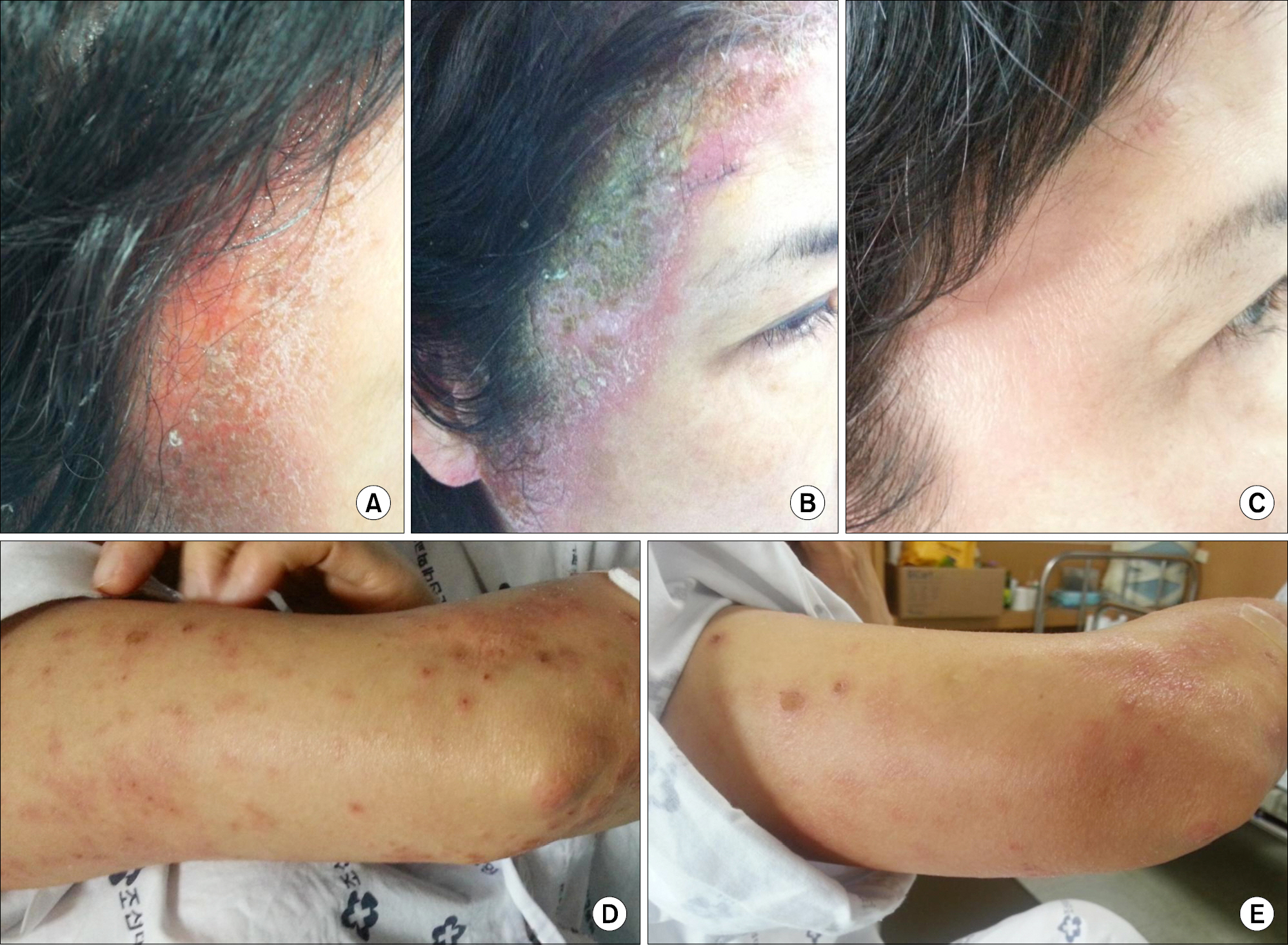J Rheum Dis.
2013 Aug;20(4):270-274. 10.4078/jrd.2013.20.4.270.
A Case of Psoriasiform Dermatitis Followed by Tumor Necrosis Factor Inhibitor Treated with Phototherapy
- Affiliations
-
- 1Department of Internal Medicine, The Chosun University College of Medicine, Gwangju, Korea.
- 2Department of Internal Medicine, Soonchunhyang University Seoul Hospital, Seoul, Korea. healthyra@schmc.ac.kr
- KMID: 2297545
- DOI: http://doi.org/10.4078/jrd.2013.20.4.270
Abstract
- Although tumor necrosis factor (TNF)-alpha antagonist is a successful treatment modality for various autoimmune diseases, including rheumatoid arthritis (RA), ankylosing spondylitis and psoriatic arthritis, many adverse effects have been reported. Cutaneous adverse reactions of TNF-alpha antagonist include skin rash, urticaria, lupus like rash, seborrheic dermatitis and different kinds of psoriasiform dermatitis. We report a case of psoriasiform dermatitis during TNF-alpha antagonist treatment in a 50-year-old woman with RA. The patient has been treated with adalimumab. After 2 months, she developed pruritic erythematous eruption and desquamative lesions on the head and limbs, which were defined as psoriasiform change by a skin biopsy. These skin lesions are successfully treated with combination therapy, including cessation of adalimumab, corticosteroid and phototherapy.
MeSH Terms
Figure
Reference
-
References
1. Bongartz T, Sutton AJ, Sweeting MJ, Buchan I, Matteson EL, Montori V. Anti-TNF antibody therapy in rheumatoid arthritis and the risk of serious infections and malignancies: systematic review and meta-analysis of rare harmful effects in randomized controlled trials. JAMA. 2006; 295:2275–85.2. Moustou AE, Matekovits A, Dessinioti C, Antoniou C, Sfikakis PP, Stratigos AJ. Cutaneous side effects of antitumor necrosis factor biologic therapy: a clinical review. J Am Acad Dermatol. 2009; 61:486–504.
Article3. Choi YJ, Kim DS, Park JM, Oh SH, Park YK, Lee JH. A case of psoriasiform eruption triggered by tumor necrosis factor-alpha antagonist therapy. Korean J Dermatol. 2008; 46:721–3.4. Oh JM, Koh EM, Kim H, Lee J, Ahn JK, Cha HS, et al. Exacerbation of psoriatic skin lesion followed by tnf-alpha antagonist treatment. J Korean Rheum Assoc. 2010; 17:200–4.5. Mease P. TNFalpha therapy in psoriatic arthritis and psoriasis. Ann Rheum Dis. 2004; 63:755–8.6. Alsaad KO, Ghazarian D. My approach to superficial inflammatory dermatoses. J Clin Pathol. 2005; 58:1233–41.
Article7. Mehta S, Singal A, Singh N, Bhattacharya SN. A study of clinicohistopathological correlation in patients of psoriasis and psoriasiform dermatitis. Indian J Dermatol Venereol Leprol. 2009; 75:100–10.
Article8. Schopf RE, Aust H, Knop J. Treatment of psoriasis with the chimeric monoclonal antibody against tumor necrosis factor alpha, infliximab. J Am Acad Dermatol. 2002; 46:886–91.9. Fouache D, Goëb V, Massy-Guillemant N, Avenel G, Bacquet-Deschryver H, Kozyreff-Meurice M, et al. Paradoxical adverse events of anti-tumour necrosis factor therapy for spondyloarthropathies: a retrospective study. Rheumatology (Oxford). 2009; 48:761–4.
Article10. Sfikakis PP, Iliopoulos A, Elezoglou A, Kittas C, Stratigos A. Psoriasis induced by antitumor necrosis factor therapy: a paradoxical adverse reaction. Arthritis Rheum. 2005; 52:2513–8.
Article11. de Gannes GC, Ghoreishi M, Pope J, Russell A, Bell D, Adams S, et al. Psoriasis and pustular dermatitis triggered by TNF-{alpha} inhibitors in patients with rheumatologic conditions. Arch Dermatol. 2007; 143:223–31.
Article12. Collamer AN, Guerrero KT, Henning JS, Battafarano DF. Psoriatic skin lesions induced by tumor necrosis factor antagonist therapy: a literature review and potential mechanisms of action. Arthritis Rheum. 2008; 59:996–1001.
Article
- Full Text Links
- Actions
-
Cited
- CITED
-
- Close
- Share
- Similar articles
-
- A Case of Psoriasiform Eruption Triggered by Tumor Necrosis Factor-alpha Antagonist Therapy
- A Case of Exfoliative Dermatitis Induced by Phototherapy Secondary to Pustular Psoriasis
- Dermatological Side Effects of Anti-tumor Necrosis Factor Alpha Therapy
- A Case of Psoriasiform Dermatitis Following Adalimumab Injection for Treatment of Ankylosing Spondylitis
- UVB Phototherapy in Atopic Dermatitis



